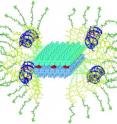Self-assembled viruses
Viruses are true experts at importing genetic material into the cells of an infected organism. This trait is now being exploited for gene therapy, in which genes are brought into the cells of a patient to treat genetic diseases or genetic defects. Korean researchers have now made an artificial virus. As described in the journal Angewandte Chemie, they have been able to use it to transport both genes and drugs into the interior of cancer cells. Natural viruses are extremely effective at transporting genes into cells for gene therapy; their disadvantage is that they can initiate an immune response or cause cancer. Artificial viruses do not have these side effects, but are not especially effective because their size and shape are very difficult to control—but crucial to their effectiveness. A research team headed by Myongsoo Lee has now developed a new strategy that allows the artificial viruses to maintain a defined form and size.
The researchers started with a ribbonlike protein structure (â-sheet) as their template. The protein ribbons organized themselves into a defined threadlike double layer that sets the shape and size. Coupled to the outside are "protein arms" that bind short RNA helices and embed them. If this RNA is made complementary to a specific gene sequence, it can very specifically block the reading of this gene. Known as small interfering RNAs (siRNA), these sequences represent a promising approach to gene therapy.
Glucose building blocks on the surfaces of the artificial viruses should improve binding of the artificial virus to the glucose transporters on the surfaces of the target cells. These transporters are present in nearly all mammalian cells. Tumor cells have an especially large number of these transporters.
Trials with a line of human cancer cells demonstrated that the artificial viruses very effectively transport an siRNA and block the target gene.
In addition, the researchers were able to attach hydrophobic (water repellant) molecules—for demonstration purposes a dye—to the artificial viruses. The dye was transported into the nuclei of tumor cells. This result is particularly interesting because the nucleus is the target for many important antitumor agents.
Source: Wiley-Blackwell
Other sources
- Self-assembled virusesfrom Biology News NetFri, 30 May 2008, 20:49:05 UTC
- Self-assembled Viruses Efficiently Carry Genes And Drug Molecules Into Tumor Cellsfrom Science DailyFri, 30 May 2008, 15:14:11 UTC
- Self-Assembled Virusesfrom PhysorgFri, 30 May 2008, 12:28:14 UTC
